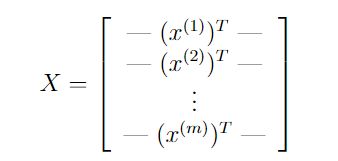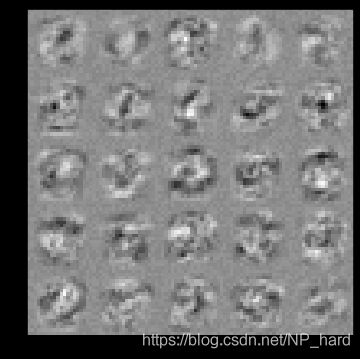吴恩达机器学习作业4---Neural Networks Learning
Neural Networks Learning
文章目录
-
-
- Neural Networks Learning
- 代码分析
- 数据集
-
- ex4data1.mat
- ex4weights.mat
-
代码分析
首先,下图为本次需要构建的神经网络模型
输入为一张20x20的图片,用以识别手写数字
该神经网络分为三层,输入层有400+1(bias unit)个单元,隐藏层有25+1个单元,输出层有10个单元
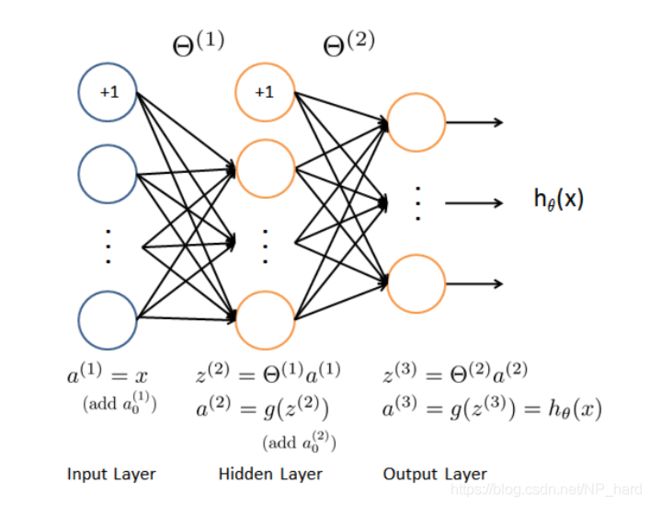
训练一个神经网络模型主要分为几个步骤
- 随机初始化参数θ
- 执行正向传播,得到每一层的(z,a)
- 执行反向传播,对参数进行梯度下降
为了构建神经网络模型,我们需要实现正向传播函数,cost值计算函数,反向传播函数,由这三个函数来对参数theta进行优化,最终得到cost值最小的模型
首先,导入所需的类库
import numpy as np
import matplotlib.pyplot as plt
import pandas as pd
import scipy.io #Used to load the OCTAVE *.mat files
import scipy.misc #Used to show matrix as an image
import matplotlib.cm as cm #Used to display images in a specific colormap
import random #To pick random images to display
import scipy.optimize #fmin_cg to train neural network
import itertools
from scipy.special import expit #Vectorized sigmoid function
%matplotlib inline
导入数据
这次作业提供了已经优化好的参数theta以供测试
#导入已经优化后的单隐藏层神经网络的参数theta
datafile = 'data/ex3weights.mat'
mat = scipy.io.loadmat( datafile )
Theta1, Theta2 = mat['Theta1'], mat['Theta2']
# Theta1 has size 25 x 401
# Theta2 has size 10 x 26
还有一些全局变量
input_layer_size = 400
hidden_layer_size = 25
output_layer_size = 10
n_training_samples = X.shape[0]
好了,现在开始导入训练集
#导入数据,由于ex3和ex4的数据相同,这里导入ex3的数据
datafile = 'data/ex3data1.mat'
mat = scipy.io.loadmat( datafile )
X, y = mat['X'], mat['y']
#在X矩阵前插入全为1的一列作为bias unit
X = np.insert(X,0,1,axis=1)
#测试
print ("'y' shape: %s. Unique elements in y: %s"%(mat['y'].shape,np.unique(mat['y'])))
print ("'X' shape: %s. X[0] shape: %s"%(X.shape,X[0].shape))
#X is 5000 images. Each image is a row. Each image has 400 pixels unrolled (20x20)
#y is a classification for each image. 1-10, where "10" is the handwritten "0"
测试结果
'y' shape: (5000, 1). Unique elements in y: [ 1 2 3 4 5 6 7 8 9 10]
'X' shape: (5000, 401). X[0] shape: (401,)
可视化这些数据
将400的行向量转为20x20的ndarray的函数
def getDatumImg(row):
width, height = 20, 20
#row.shape=401
#将400的行向量转为20x20的narray
square = row[1:].reshape(width,height)
return square.T
可视化数据为黑白图片
def displayData(X,indices_to_display = None):
#图片格式为20x20
width, height = 20, 20
#10x10的图像网格
nrows, ncols = 10, 10
#5000张图片中随机抽取100张
if not indices_to_display:
indices_to_display = random.sample(range(X.shape[0]), nrows*ncols)
#200x200的narray
big_picture = np.zeros((height*nrows,width*ncols))
#遍历图片集,为空白的大图片赋值
irow, icol = 0, 0
for idx in indices_to_display:
if icol == ncols:
irow += 1
icol = 0
iimg = getDatumImg(X[idx])
#将这块区域的图片赋值
big_picture[irow*height:irow*height+iimg.shape[0],icol*width:icol*width+iimg.shape[1]] = iimg
icol += 1
#输出图片
fig = plt.figure(figsize=(6,6))
plt.imshow(big_picture,cmap ='gray')
测试
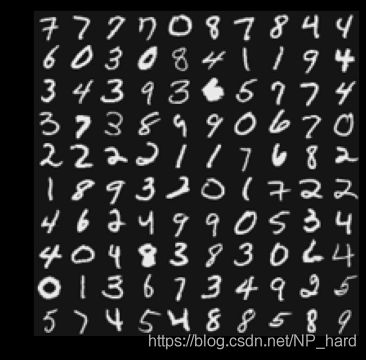
在正式对神经网络模型进行训练前,我们需要对数据进行处理
对于本次作业而言,参数theta为矩阵,不利于进行计算,这里我们要将其展开为行向量
该函数将theta_list展开为一个(n,1)行向量ndarray
#将theta_list展开为一个(n,1)行向量ndarray
def flattenParams(thetas_list):
#将参数θ矩阵展开为行向量并合并到一个list中
flattened_list = [ mytheta.flatten() for mytheta in thetas_list ]
#将装有两个ndarray的list转换为一个list
combined = list(itertools.chain.from_iterable(flattened_list))
assert len(combined) == (input_layer_size+1)*hidden_layer_size + \
(hidden_layer_size+1)*output_layer_size
return np.array(combined).reshape((len(combined),1))
该函数将行向量ndarray重新展开为参数矩阵
#将行向量ndarray重新展开为参数矩阵
def reshapeParams(flattened_array):
theta1 = flattened_array[:(input_layer_size+1)*hidden_layer_size].reshape((hidden_layer_size,input_layer_size+1))
theta2 = flattened_array[(input_layer_size+1)*hidden_layer_size:].reshape((output_layer_size,hidden_layer_size+1))
return [ theta1, theta2 ]
下面这两个函数可以对X进行展开与收缩
def flattenX(myX):
return np.array(myX.flatten()).reshape((n_training_samples*(input_layer_size+1),1))
def reshapeX(flattenedX):
return np.array(flattenedX).reshape((n_training_samples,input_layer_size+1))
好了,下面开始编写正向传播算法和cost值计算函数
下面的函数为正向传播函数,参数为一张图片和初始化的theta
它将会计算每一层的(z,a)
#参数为训练集的某个数据,每层神经网络的参数theta
def propagateForward(row,Thetas):
features = row#row为某个训练集
zs_as_per_layer = []
#遍历每一层
for i in range(len(Thetas)):
Theta = Thetas[i]
z = Theta.dot(features).reshape((Theta.shape[0],1))
a = expit(z)
zs_as_per_layer.append( (z, a) )
if i == len(Thetas)-1:
return np.array(zs_as_per_layer)
a = np.insert(a,0,1) #加上bias unit
features = a
下面的函数为cost值计算函数,它将会计算所有训练集的平均cost值
#传入处理过的参数theta,数据集(X,y)
def computeCost(mythetas_flattened,myX_flattened,myy,mylambda=0.):
#先将参数重新变为矩阵
mythetas = reshapeParams(mythetas_flattened)
myX = reshapeX(myX_flattened)
total_cost = 0.
m = n_training_samples
#先使用遍历训练集的方法,后续会考虑向量化
for irow in range(m):
myrow = myX[irow]#某个图片
myhs = propagateForward(myrow,mythetas)[-1][1]#myhs是神经网络输出层的激发值
tmpy = np.zeros((10,1))#tmpy为某个图像数字的向量值
tmpy[myy[irow]-1] = 1
#计算cost值
mycost = -tmpy.T.dot(np.log(myhs))-(1-tmpy.T).dot(np.log(1-myhs))
total_cost += mycost
total_cost = float(total_cost) / m
# 计算正则项
total_reg = 0.
for mytheta in mythetas:
total_reg += np.sum(mytheta*mytheta) #element-wise multiplication
total_reg *= float(mylambda)/(2*m)
return total_cost + total_reg
我们测试一下训练好的参数theta的平均cost如何
#you should see that the cost is about 0.287629
myThetas = [ Theta1, Theta2 ]
#测试
print (computeCost(flattenParams(myThetas),flattenX(X),y))
输出:0.28762916516131876
下面我们测试一下加入正则化项的平均cost如何
#and lambda = 1, you should see that the cost is about 0.383770
myThetas = [ Theta1, Theta2 ]
print (computeCost(flattenParams(myThetas),flattenX(X),y,mylambda=1.))
输出:0.3844877962428938
明显看出加入正则化项之后的cost要大,即参数对训练集的拟合度减小,防止过拟合
好,下面进行反向传播算法的编写
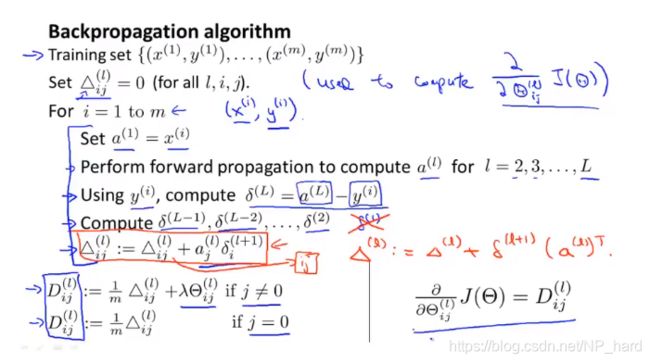
就像对其他模型进行梯度下降算法,我们需要得到J(θ)对θ的偏导数才能进行
梯度下降
θ i j : = θ i j − α ∂ J ( θ ) ∂ θ i j ( l ) \theta_{ij}:=\theta_{ij}-\alpha\frac{\partial J(\theta)}{\partial \theta_{ij}^{(l)}} θij:=θij−α∂θij(l)∂J(θ)
而通过数学证明(忽略α)
∂ J ( θ ) ∂ θ i j ( l ) = a j ( l ) δ i ( l + 1 ) \frac{\partial J(\theta)}{\partial \theta_{ij}^{(l)}}=a_{j}^{(l)}\delta_{i}^{(l+1)} ∂θij(l)∂J(θ)=aj(l)δi(l+1)
又因为某个单元的梯度为所有训练集的平均梯度
故
∂ J ( θ ) ∂ θ i j ( l ) = 1 m Δ i j ( l ) \frac{\partial J(\theta)}{\partial \theta_{ij}^{(l)}}=\frac{1}{m}\Delta_{ij}^{(l)} ∂θij(l)∂J(θ)=m1Δij(l)
这是反向传播算法的函数,返回D1,D2展开的numpy数组
#传入处理过的参数theta,数据集(X,y)
#返回每层参数theta的偏导数
def backPropagate(mythetas_flattened,myX_flattened,myy,mylambda=0.):
#首先将行向量转化为矩阵
mythetas = reshapeParams(mythetas_flattened)
myX = reshapeX(myX_flattened)
#Note: the Delta matrices should include the bias unit
#The Delta matrices have the same shape as the theta matrices
#初始化δ
Delta1 = np.zeros((hidden_layer_size,input_layer_size+1))
Delta2 = np.zeros((output_layer_size,hidden_layer_size+1))
# Loop over the training points (rows in myX, already contain bias unit)
m = n_training_samples
for irow in range(m):
myrow = myX[irow]#某个图像
a1 = myrow.reshape((input_layer_size+1,1))#再次将图像矩阵展开为行向量
# propagateForward returns (zs, activations) for each layer excluding the input layer
#temp包含除了输入层的(z,a)
temp = propagateForward(myrow,mythetas)
z2 = temp[0][0]
a2 = temp[0][1]
z3 = temp[1][0]
a3 = temp[1][1]
tmpy = np.zeros((10,1))#tmpy为某个图像数字的向量值(即答案)
tmpy[myy[irow]-1] = 1
delta3 = a3 - tmpy
delta2 = mythetas[1].T[1:,:].dot(delta3)*sigmoidGradient(z2) #参数θ忽略bias unit
a2 = np.insert(a2,0,1,axis=0)
Delta1 += delta2.dot(a1.T) #(25,1)x(1,401) = (25,401) (correct)
Delta2 += delta3.dot(a2.T) #(10,1)x(1,25) = (10,25) (should be 10,26)
D1 = Delta1/float(m)
D2 = Delta2/float(m)
#正则化
D1[:,1:] = D1[:,1:] + (float(mylambda)/m)*mythetas[0][:,1:]
D2[:,1:] = D2[:,1:] + (float(mylambda)/m)*mythetas[1][:,1:]
return flattenParams([D1, D2]).flatten()
利用提供的参数theta计算一次梯度
#Actually compute D matrices for the Thetas provided
flattenedD1D2 = backPropagate(flattenParams(myThetas),flattenX(X),y,mylambda=0.)
D1, D2 = reshapeParams(flattenedD1D2)
检查反向传播计算的梯度是否准确
#传入参数,偏导数,数据集(X,y)
def checkGradient(mythetas,myDs,myX,myy,mylambda=0.):
myeps = 0.0001
#将参数化为行向量
flattened = flattenParams(mythetas)
flattenedDs = flattenParams(myDs)
myX_flattened = flattenX(myX)
n_elems = len(flattened)
#Pick ten random elements, compute numerical gradient, compare to respective D's
#随机选择10个元素,计算偏导数以比较
for i in range(10):
x = int(np.random.rand()*n_elems)
epsvec = np.zeros((n_elems,1))
epsvec[x] = myeps
cost_high = computeCost(flattened + epsvec,myX_flattened,myy,mylambda)
cost_low = computeCost(flattened - epsvec,myX_flattened,myy,mylambda)
mygrad = (cost_high - cost_low) / float(2*myeps)
print ("Element: %d. Numerical Gradient = %f. BackProp Gradient = %f."%(x,mygrad,flattenedDs[x]))
测试
checkGradient(myThetas,[D1, D2],X,y)
Element: 10113. Numerical Gradient = -0.000927. BackProp Gradient = -0.000927.
Element: 3468. Numerical Gradient = -0.000036. BackProp Gradient = -0.000036.
Element: 4309. Numerical Gradient = 0.000051. BackProp Gradient = 0.000051.
Element: 9991. Numerical Gradient = -0.000149. BackProp Gradient = -0.000149.
Element: 1241. Numerical Gradient = 0.000001. BackProp Gradient = 0.000001.
Element: 9973. Numerical Gradient = 0.000174. BackProp Gradient = 0.000174.
Element: 8678. Numerical Gradient = 0.000160. BackProp Gradient = 0.000160.
Element: 4224. Numerical Gradient = -0.000084. BackProp Gradient = -0.000084.
Element: 526. Numerical Gradient = -0.000085. BackProp Gradient = -0.000085.
Element: 7040. Numerical Gradient = 0.000085. BackProp Gradient = 0.000085.
好的,算法都编写完了,我们开始自己优化参数theta吧
该函数可以计算得出优化后的θ
#训练神经网络模型
def trainNN(mylambda=0.):
#随机初始化theta
randomThetas_unrolled = flattenParams(genRandThetas())
#优化theta,参数为:代价函数,初始参数theta,数据集(X,y)
result = scipy.optimize.fmin_cg(computeCost, x0=randomThetas_unrolled, fprime=backPropagate, \
args=(flattenX(X),y,mylambda),maxiter=50,disp=True,full_output=True)
return reshapeParams(result[0])
测试
learned_Thetas = trainNN()
Current function value: 0.252900
Iterations: 50
Function evaluations: 115
Gradient evaluations: 115
下面计算模型在训练集的准确率
这个函数可以返回概率最大的数字
#返回概率最大的数字
def predictNN(row,Thetas):
classes = list(range(1,10)) + [10]
output = propagateForward(row,Thetas)
#-1 means last layer, 1 means "a" instead of "z"
return classes[np.argmax(output[-1][1])]
这个函数计算模型准确率
#计算模型准确率
def computeAccuracy(myX,myThetas,myy):
n_correct, n_total = 0, myX.shape[0]
for irow in range(n_total):
if int(predictNN(myX[irow],myThetas)) == int(myy[irow]):
n_correct += 1
print ("Training set accuracy: %0.1f%%"%(100*(float(n_correct)/n_total)))
测试
computeAccuracy(X,learned_Thetas,y)
Training set accuracy: 97.0%
看看正则化参数为10时的准确率
#Let's see if I set lambda to 10, if I get the same thing
learned_regularized_Thetas = trainNN(mylambda=10.)
Current function value: 1.071414
Iterations: 49
Function evaluations: 164
Gradient evaluations: 152
computeAccuracy(X,learned_regularized_Thetas,y)
Training set accuracy: 93.6%
可以看出正则化的效果
可视化隐藏层所识别的图像
def displayHiddenLayer(myTheta):
"""
Function that takes slices of the first Theta matrix (that goes from
the input layer to the hidden layer), removes the bias unit, and reshapes
it into a 20x20 image, and shows it
"""
#删去bias unit:
myTheta = myTheta[:,1:]
assert myTheta.shape == (25,400)
width, height = 20, 20
nrows, ncols = 5, 5
big_picture = np.zeros((height*nrows,width*ncols))
irow, icol = 0, 0
for row in myTheta:
if icol == ncols:
irow += 1
icol = 0
#add bias unit back in?
iimg = getDatumImg(np.insert(row,0,1))#将400的行向量转为20x20的ndarray
big_picture[irow*height:irow*height+iimg.shape[0],icol*width:icol*width+iimg.shape[1]] = iimg
icol += 1
fig = plt.figure(figsize=(6,6))
plt.imshow(big_picture,cmap ='gray')
测试
displayHiddenLayer(learned_Thetas[0])
数据集
可以上kaggle搜索这些数据
